Stocked Trout Fishing: TLDR Rundown
(with video below)
Stocked trout fishing is the stepping stone for many anglers into fly fishing -
Click here to get inspired by this video.
You can certainly find experiences that will help you take your first successful steps in your own fly fishing. This guide will show you some great experiences and get you on the path to success.
It’s a mistake to think it’s always easy though. Catch and release small stillwater fisheries - as well as large reservoir fisheries – can offer some of the most difficult fishing challenges you’ll ever face.
Learning to cover specific depths of water is probably the most important skill for this style (a brilliant transferrable skill for LURE/SPIN FISHING & BAITCASTING)
The Brits aren’t too hot at many things, but stillwater trout fishing is one thing they can do!
Our reasons for steering you towards stillwaters for this style of fishing are also given in the “Stocked Trout Fishing in Rivers” section.
This article includes:
Stocked Trout Fishing in Stillwaters
A rainy day with the rivers blown out in the Italian Alps…No problem for Vito and the Orvis Guides Dana and Hutch turning to a day of stillwater stocked trout fishing in an Alpine lake:
Put and Take Revolution
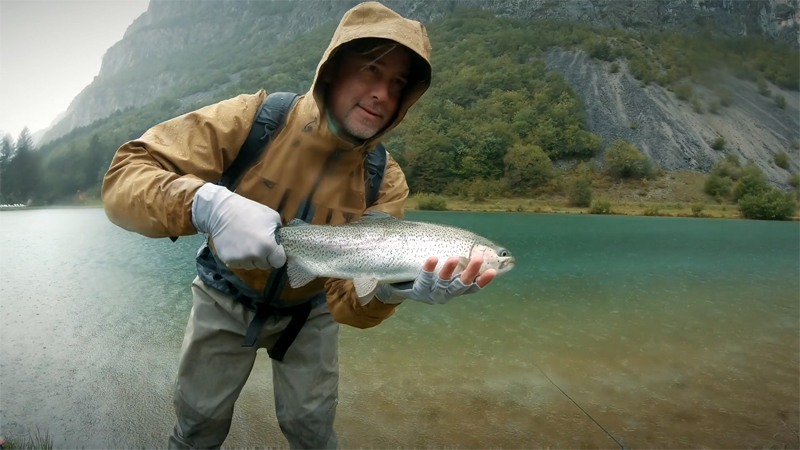
Stillwaters have been stocked with hand-reared trout for many decades. From the mid 1960s onwards, there was a revolution in fly fishing in the UK as drinking water reservoirs were stocked with rainbow trout for the first time. Anglers such as the famous Dick Walker created "reservoir" flies (including Walker's "Polystickle" to imitate baitfish - especially the Stickleback):
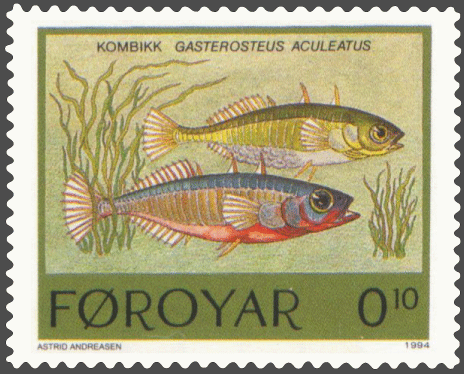
Faroe Islands Postage Stamp with Sticklebacks!
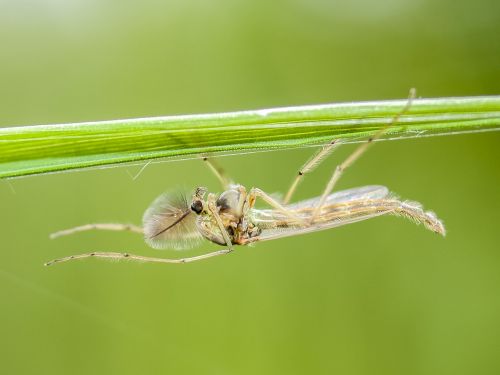
A non-biting chironomid midge - known as "buzzers" by anglers
Many specialised nymph patterns - especially for imitating "buzzers" (large, non-biting chironomid pupae that occur in huge numbers in stillwaters) were developed over time. Alongside the emergence of that "new" arm of fly fishing, the rise of smaller lakes opening as "put and take" fisheries (where trout are hand-reared and stocked into lakes for anglers to catch and take home to eat) sparked another wave of independent tactical advances.
As a young teenager, I devoured all the information I could get my hands on to learn the techniques that emerged from the stocked trout fishing revolution. I've really happy memories of that so I hope you don't mind if I share a flashback or two from my old photos album?
OLD SCANNED PHOTOS ALERT!
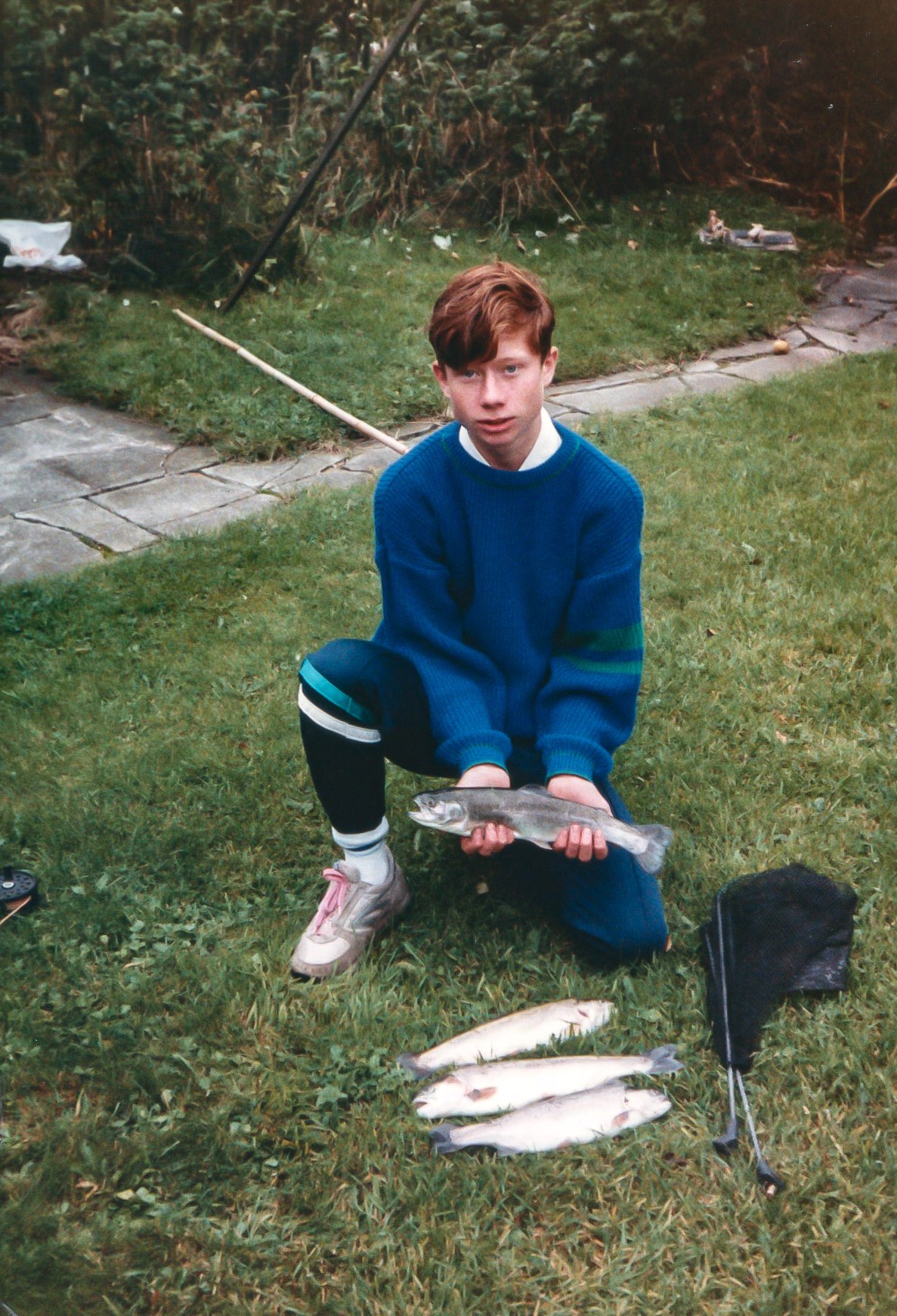
I believe I'm around 14 or 15 years old here judging by the laces/tracksuit combo! The stocked rainbow trout were from Croston Twin Lakes
I was 13 when I first caught a trout on a fly - after my brother, Ian, and my dad had taught me to fish with bait and spinners for 7 years or so before that. The venue was Croston Twin Lakes, the nearest stocked trout fishery to where I grew up. I remember clearly that it was caught on a "Jack Frost" - a white marabou "lure" style of fly (see below for definitions). At the time it seemed very important to bring home proof of success in the form of trout for dinner!
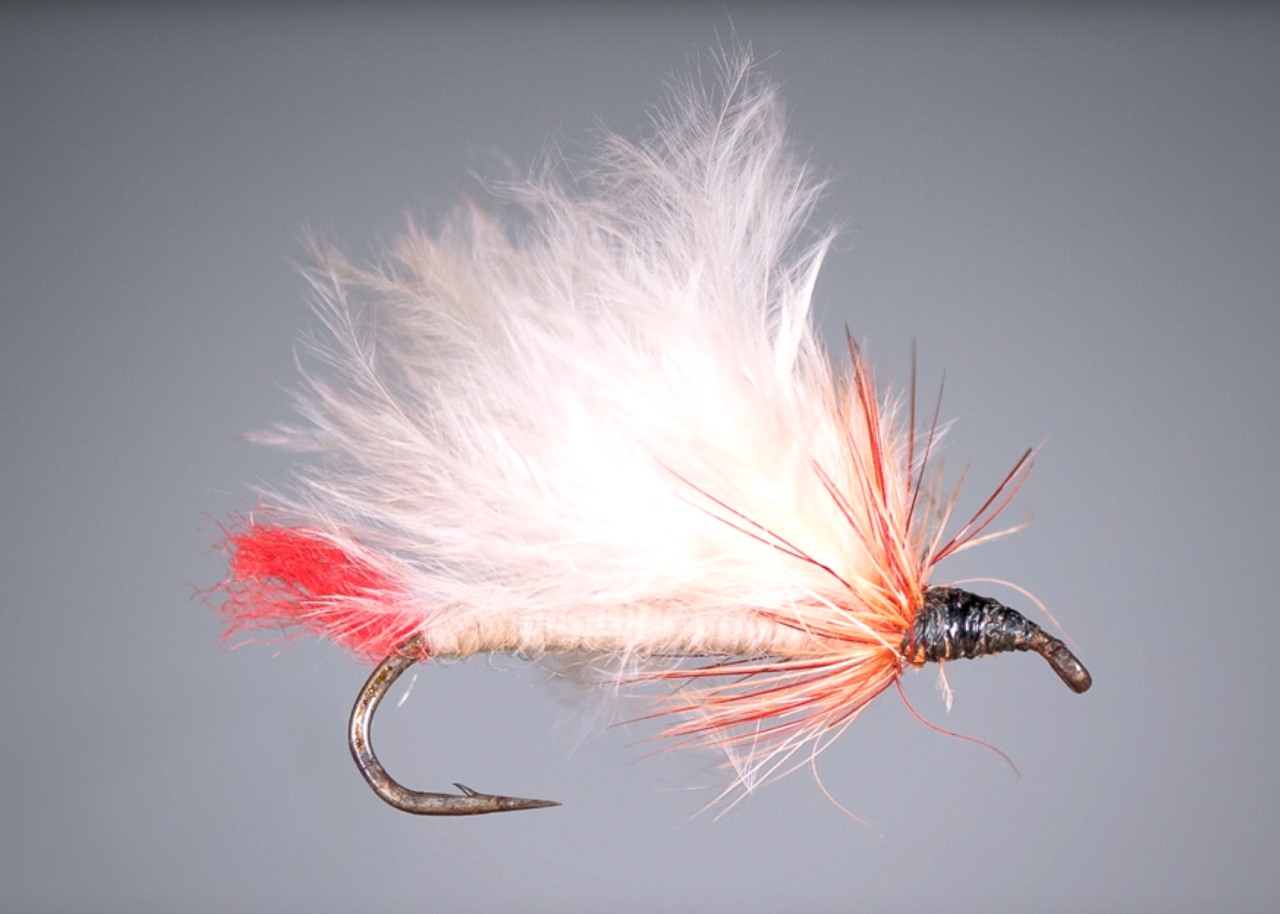
Recent photograph of a 30-year old "Jack Frost" lure from my own box. The fly in this picture was tied and fished in the same era as the photo above (It seems to have lost its clear polythene strip wraps that originally covered the body!). Note the barbed hook for catch & kill fishing
I fished at Croston Twin Lakes for many years - along with places such as Hurlston Hall (I believe both of those venues are now operated as different health/leisure businesses these days). The lessons I learned by fishing these waters with a fly rod have come in EXTREMELY handy when developing baitcasting/spincasting techniques. Yes, that's another example of the "Fishing Discoveries Cross-Training" ethos...
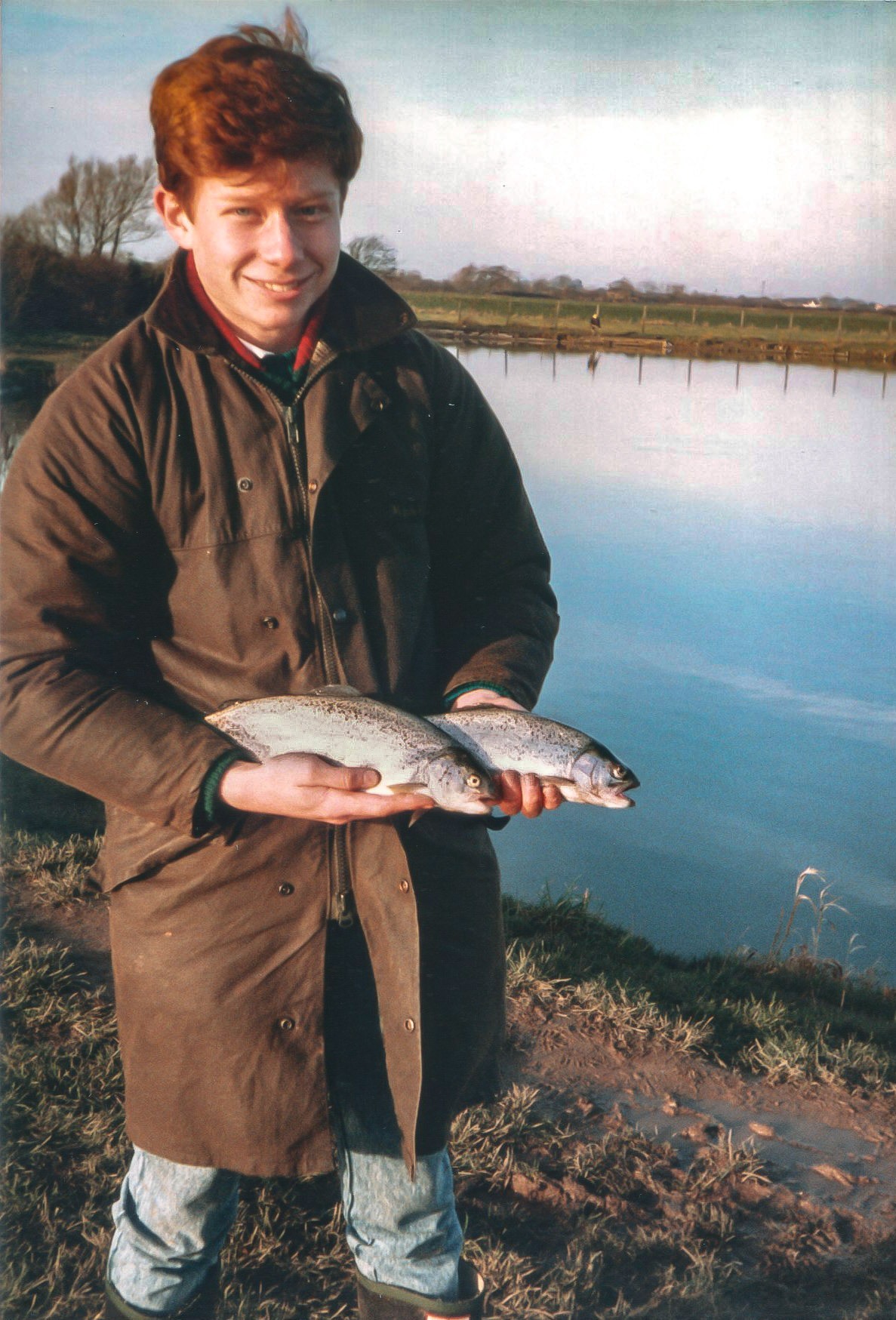
Another scanned photo from my album. I'm age 16 or 17 here with two stocked rainbow trout kept for dinner (from memory this was a Boxing Day fishing trip with Ian and my dad). The fishery is Croston Twin Lakes.
Whenever we went on holiday as a family, I was always on the lookout for the nearest stocked trout fishery - before Ian helped me to begin fishing the large drinking water reservoirs in England.

Bewl Reservoir in Kent. I'm about 18 here and Ian was working in Surrey (I got a ton of informal coaching from him on the waters he fished). The rainbow trout stocked here were always extremely strong fighters and with very distinctive, silvery flanks and greenish backs.
Ultimately that led on to me fishing for wild trout and sea-trout in the great Loughs of Ireland and some of the lochs in Scotland. From there I was able to transition into river fly fishing for wild fish.
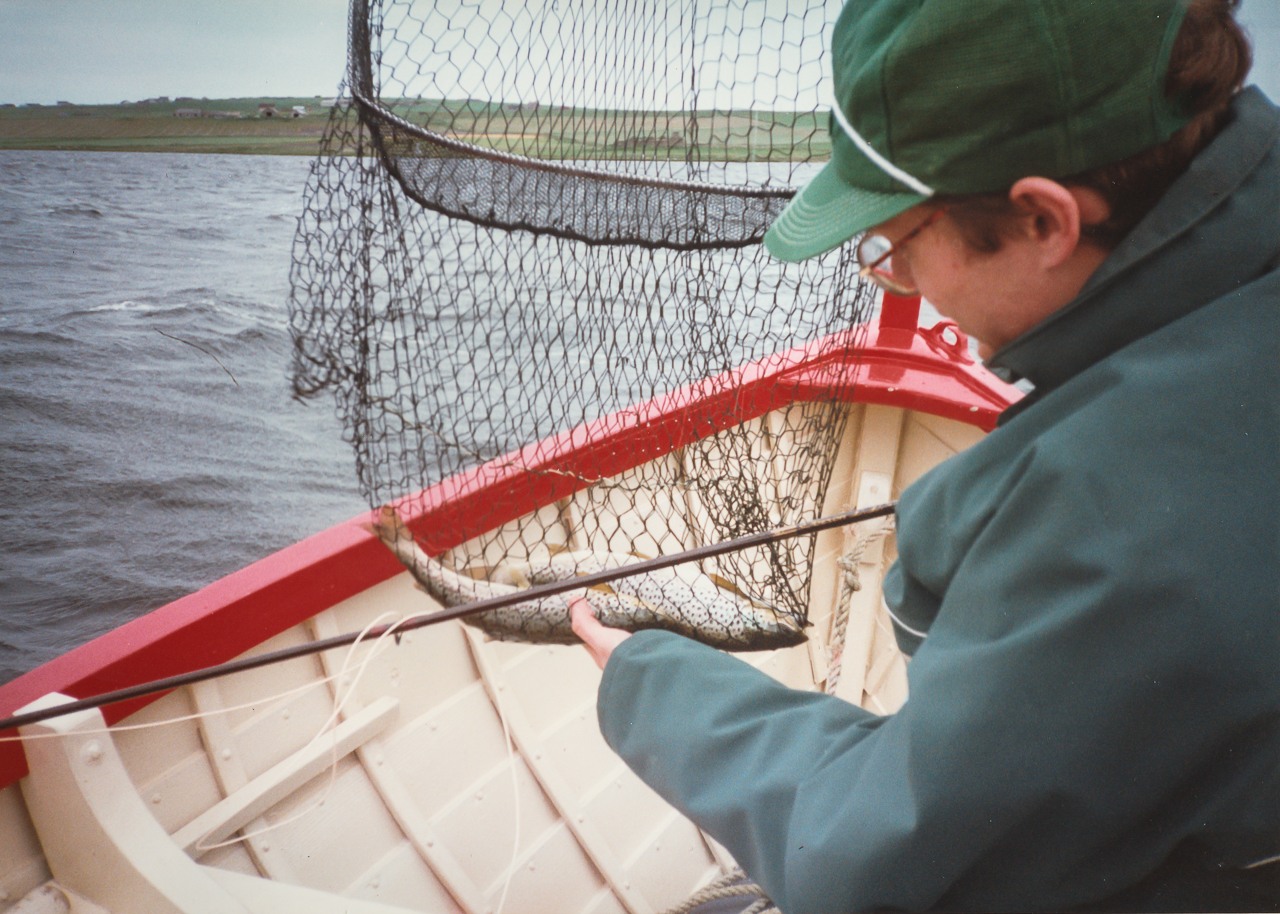
Transitioning to Wild Fishing: Age 19 or 20 and a happy memory of a "double hook up" on wild Orkney brown trout on traditional flies and traditional loch-style tactics. These fish were returned and, over time, I definitely came to appreciate the value of catch & release for wild stocks.
With the broad timeline of my early trout fishing "career" in place, it feels appropriate to begin at the same point as I started my own fly fishing journey - with small, stocked-stillwater fisheries...
Small Stillwaters
Stocked lakes that are small enough to walk around in less than half an hour or so would probably be classed as small stillwaters. These can be farm ponds, estate lakes, small Victorian drinking water reservoirs. old pits (Croston Twin Lakes used to be a pair of brick-works pits) and many more "converted" waterbodies. They are usually small lakes that have been modified from their original function by the new owners. With landscaping and stocking of trout - an interesting trout fishing experience can be created.
A Wide Range of Stocked Trout Fishing Experiences
Around the world there are many, many stillwaters offering stocked trout fishing opportunities. Rainbow trout (including their selectively-bred strain known as "blue trout") are by far the most common species in these fisheries - though some venues may offer brown trout, tiger trout, brook trout or even "Sparctic" trout too.

My nephew Shaun Gaskell with a chunky Sparctic Trout from Bank House Fishery
Learning the tactics used by British anglers on stocked stillwater trout fisheries (small and large) will serve you really well anywhere in the world. Here's a photo (below) from 2012 in Czechia (then known as the Czech Republic) when myself and John squeezed in a last morning of stillwater stocked trout fishing fishing (on the end of a predominantly river-fishing trip) before leaving for the airport:
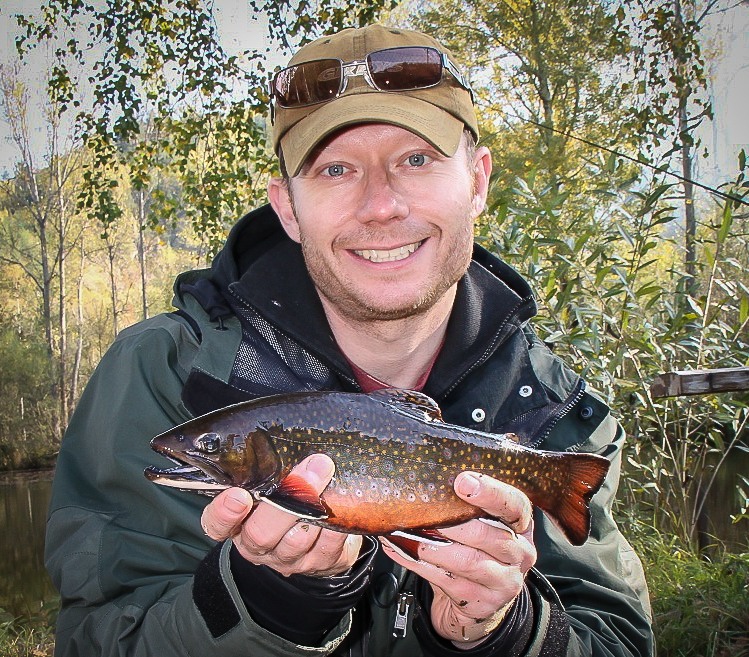
Stunning colours in this brook trout from a small, stocked stillwater in Czechia in 2012 (I'm not sure what happened to that fresh-faced youngster from the earlier pictures ha ha ha)
British Anglers' Strong Suit
Although the UK now has a world champion river angler in Howard Croston, it's true to say that the best tactics for RIVER FLY FISHING have been developed in continental Europe - which everyone else then has to copy to keep up.
The reverse is true on the world stage for STILLWATER STOCKED TROUT FISHING - where other countries have had to copy and adapt the techniques developed by British anglers. So it doesn't matter if you're in the USA, Continental Europe (even up a mountain with lashing rain being filmed in the Italian Alps ha ha), Britain, Japan or wherever, there's a solid technique base for you in those "typically British" methods.
Basic Tactics for Stocked Trout Fishing on Small Stillwaters
The first approach to learn for stillwater stocked trout fishing (once you can cast a fly rod) is to throw a single "lure" style of fly (see "flies" section below) on a floating line. The KEY thing to develop is to understand that you need to find the feeding depth of the trout. The next tip will serve you well in your lure/spin-fishing too (remember we're all about the cross-training at Fishing Discoveries!):
In warmer weather start out searching the surface layers of the water with an unweighted - or even buoyant - lure. Then work DOWN through the depths using increasingly heavy flies (or changing to sinking fly lines)
In colder weather, start searching from the lake-bed and work UP through the depths until you find the fish
Remember: trout in stillwaters don't like to move much outside of a two-foot depth-band, so getting your fly into that feeding depth is CRITICAL to your success
LEARN TO "COUNT DOWN" YOUR FLIES or SPINNING LURES...Starting at Zero when they hit the water...If you can remember how many seconds sinking-time on each cast - you can lock in on the depth where you start to get hits from fish.
Here's a diagram to help you picture this process more clearly for yourself. The setup is a floating fly line with a slightly weighted fly. Your fly can be retrieved in the same way that you see on the video at the top of this article (by drawing line through your "trigger finger" of your rod-hand). Learning a good variety of these retrieve styles is key to becoming a good stillwater fly fisher.
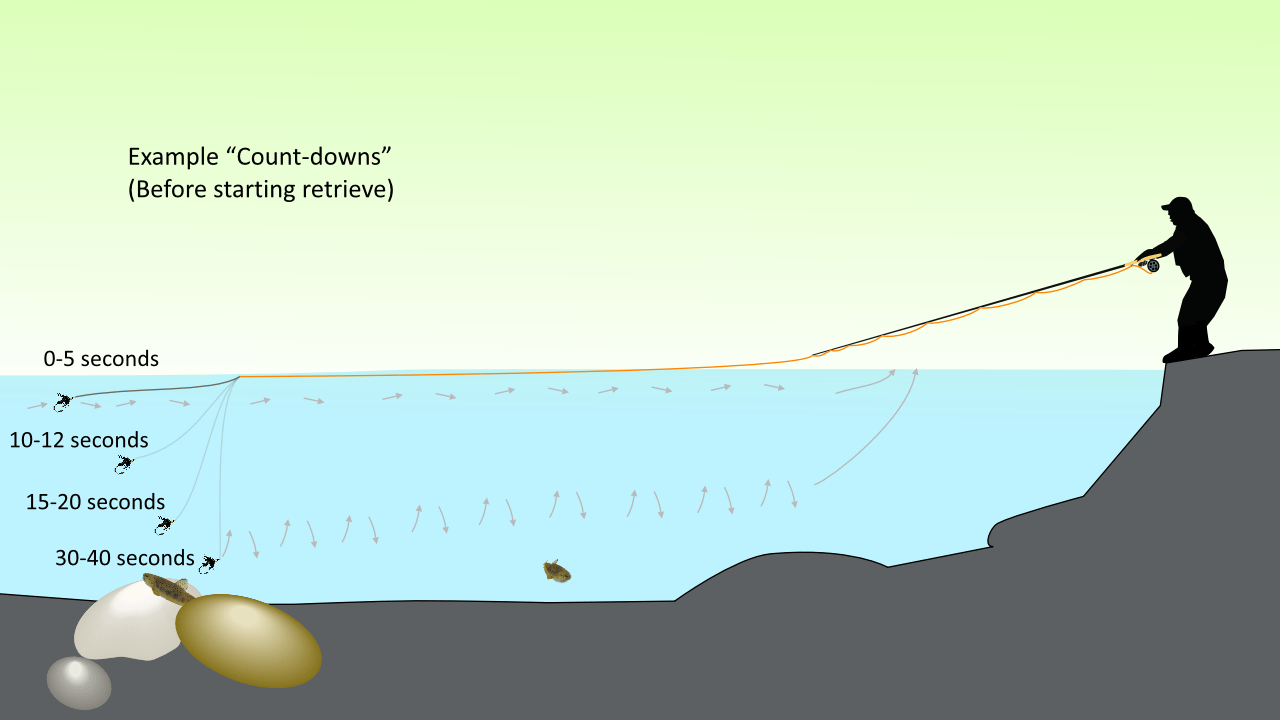
After casting out, count how long you let your fly sink before starting to pull it back to you. Remember that the speed of your retrieve (how fast you pull the fly towards you) will affect both the depth it fishes at AND the path of the fly through the water. With a floating line, the deeper a fly is, the more "up and down" the action of that fly through the water (as shown by the grey arrows in the picture). When you start getting fish, remember how long you counted down. That way, you know you can get your fly to the right depth time after time (until the fish change what they're doing again!)
Once you've got the idea above - try to imagine what effect using fly lines with different sinking rates will have. Then combine that with slightly buoyant flies, neutral density flies, lightly weighted flies etc. By combining flies of different densities/buoyancies on the same tippet with lines of different sinking rates, you open up a powerful range of presentation tactics. Combine that with a range of retrieve styles from static/drifting on the breeze, through to pulling it back as fast as you can - and you're really cooking with gas. Here's some ideas for combining skills and knowledge for this style of fishing...
Combining Fundamental Skills for Stillwater Stocked Trout Fishing
Stocked Trout Fishing on Reservoirs
The same fundamental principles you develop on small stillwaters apply on larger reservoirs too. You can fish these waters both from the bank (on foot) and also from a boat. With boat fishing, there comes a set of additional skills - which needs separate information of its own to cover properly. However, I'll cover some basics here - along with talking a bit about stocking as well.
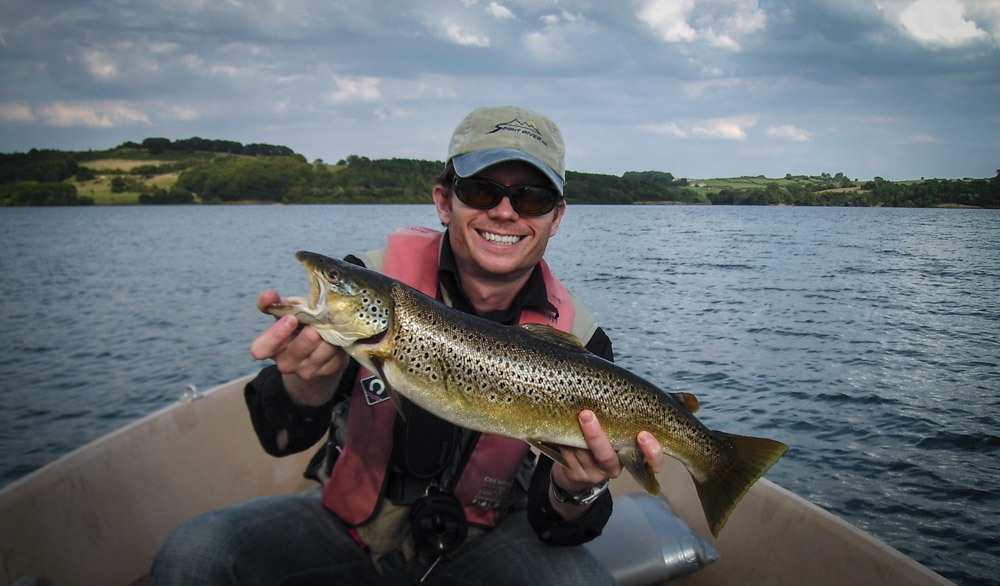
Stocked - but well "naturalised" - brown trout from Carsington Water Reservoir. Very hard fighting fish (this one was also delicious btw)...
Stocking of Drinking Water Reservoirs
As with stocked small stillwaters, the rearing and stocking of trout meant for the table is designed to avoid over-fishing impacts on wild trout stocks. In enclosed stillwaters without their own natural stocks to impact, stocking of trout can act as a stepping stone (as in my case) to fishing for wild fish on a Catch and Release basis.
For my own situation, I have ended up working professionally in the conservation of wild, native trout populations. This would almost certainly not have happened if I had not been introduced to stocked trout fishing in my early teens.
That's not to say that the practice of stocking stillwaters is a simple issue. While fish farming techniques and feeds are developing all the time, the introduction of a large biomass of fish into a lake creates a new food source for mobile predators (like fish-eating birds). Historically, the food pellets used to rear trout would contain fish-meal made from marine baitfish.
That may have contributed to a situation where there was reduced availability of marine bait-fish as prey for fish-eating birds in the sea. This also coincided with the establishment of inland/freshwater populations of those birds around stocked stillwater trout fisheries (and also inland river systems).
As you can see, the situation is far from simple - and that is before even considering the data collected on the social and community benefits of angling.
Now, with that offered as some food for thought, let's look at how to make the jump to stocked trout fishing on large reservoirs...
Basic Tactics for Reservoir Trout Fishing
If you're fishing from the bank on a large reservoir - the skills you develop on small stillwaters will be a good starting point. The potentially great depth of water in front of you means you'll probably want one or more sinking lines in your armoury (a slow sinker and a medium to fast sinker wouldn't be bad ideas).
One of the biggest shifts in your stocked trout fishing (and wild loch/lough fishing) will come when you get to grips with fishing from the front of a drifting boat. Here's a quick diagram to get you up to speed right away:
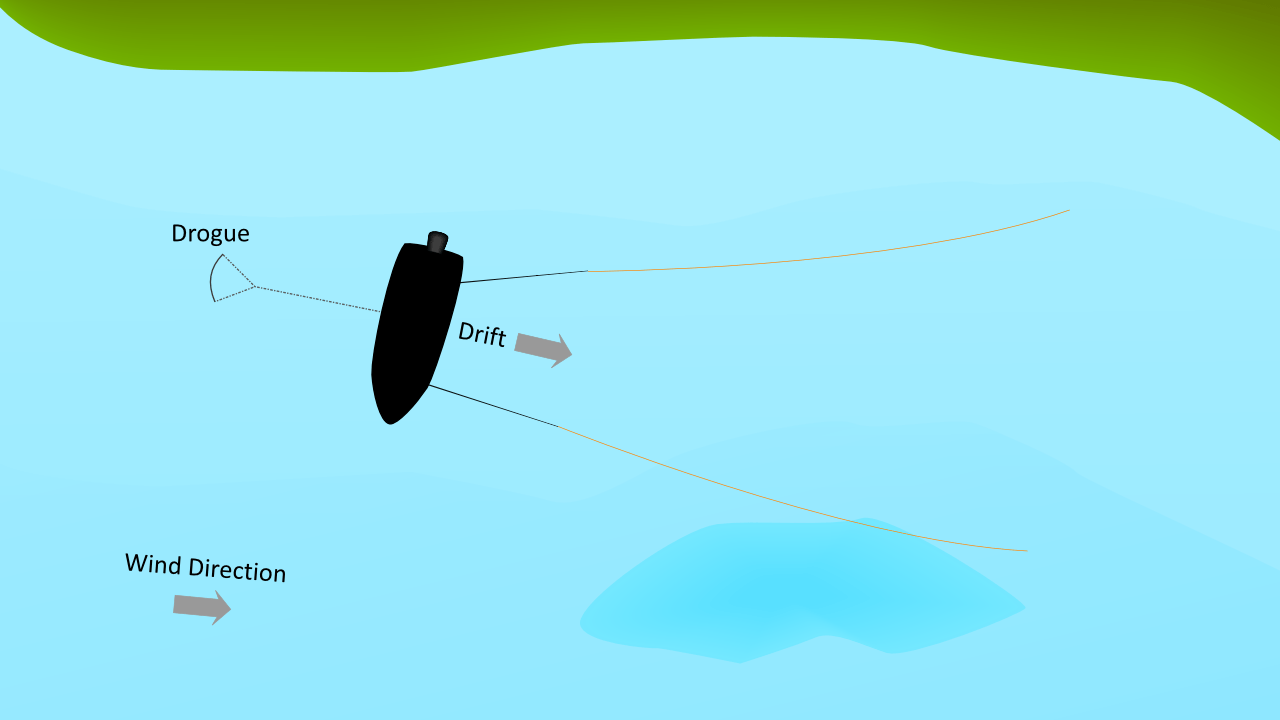
Plan View of a drifting boat with two anglers. Note that it is set to drift broadside to the wind.
In the above diagram, check out the drogue (basically a small underwater "parachute") which slows and steadies the drift. The simplest way to set the drogue is to tie the end of its cord around a seat in the boat - and then pass the cord through the rowlock on the upwind side of the boat. As you find you need more control, you can use one or more "G" clamps on the gunwhale to position the cord anchor-point. It's also worth knowing that boats tend to want to drift towards the engine.
Extending your Selection of Retrieves and Rigs
OK, so in the Small Stillwaters section, I mentioned that your retrieve speed might vary from almost static to super-fast. I also spoke about starting out with using just one fly on your tippet (or "cast").
Learning to fish with several flies on droppers - and the ways that each pattern contributes to a special "team" of flies which have a combined function - is a vital building block to getting great at stillwater stocked trout fishing. Secondly, nailing down some of the special, named retrieve tactics is also an important step.
In the home-made trip-log video that my nephew Shaun made with a chest-mounted GoPro (below), you'll get a first-person demo of an infamous "secret weapon" retrieve.
Although it's no longer allowed in some competitions, the "Roly Poly" retrieve is an essential option for your pleasure fishing trips (as well as the competitive events you CAN use it in).
It involves tucking the rod handle under one arm and using both hands to draw in the line.
Because it's difficult to describe in words, your best option is to just watch Shaun do it in his video...
Also note the moment from 4 min and 45 seconds onwards where a fish swirls at his fly (and misses). Shaun then picks off and re-delivers his flies to the fish - and catches it!
Shaun Gaskell - demonstrating the Roly-Poly fast retrieve and catching lots of hard-fighting rainbows on Stocks Reservoir:
The "Washing Line" technique for presenting teams of flies is another game-changer - and here's a complete rundown by Ben Dobson of Stocks Reservoir in one of the video tutorials he made to help anglers on his fishery. Notice how this can be a much slower presentation - almost the complete opposite of the fast Roly Poly. Also notice, again, how different flies complement each other to make a good "team":
Reservoir Dry Fly: In the final taster of special tactics for this article, Ben Dobson explains some of the modifications to "standard" river dry fly fishing. These tips can help you boost your results when transitioning to reservoirs; including tippet material, short casting and - again - building teams of flies...
Flies for Stocked Trout Fishing on Stillwaters
The designs of flies for targeting stocked trout in stillwaters is one of the most active and creative branches of our sport. American river anglers are generally ahead of the Brits when it comes to streamer fishing on rivers. However, the British anglers's "lure" and "nymph" fly boxes for stillwater fishing are likely to be eye-openers for most US fly rodders.
First of all - two important definitions:
Lures
The stillwater flies known as "lures" to British anglers are attractor patterns that do not, generally, directly imitate a natural food source. The exceptions are patterns might act as imitations of bait-fish (however, these are normally flagged up as "fry patterns". Instead, most lures are designed to provoke an attack from a trout either out of curiosity or aggression. Sometimes the colours and enticing actions of lures could be flicking deep-rooted biological switches. One of the most extreme examples of an out-and-out lure is the "blob" - constructed from tightly-packed turns of bright, synthetic fritz chenille and nothing else.
Buzzers and "DBs"
These are the most common "nymph" patterns in stillwater stocked trout fishing. They are designed to mimic or suggest the pupae of non-biting "chironomid" midges. Buzzer patterns tend to be more deliberately imitative - with the DBs (Diawl Bachs or "little devils" in Welsh) being more suggestive and impressionistic. Both styles of dressing can be fished pretty much static. When retrieved, buzzers tend to be fished at a slower maximum pace than DBs (which are sometimes stripped back pretty fast).
Here's just a small selection of some of Steve Cullen's favourite reservoir fly patterns (containing both lures and buzzers):
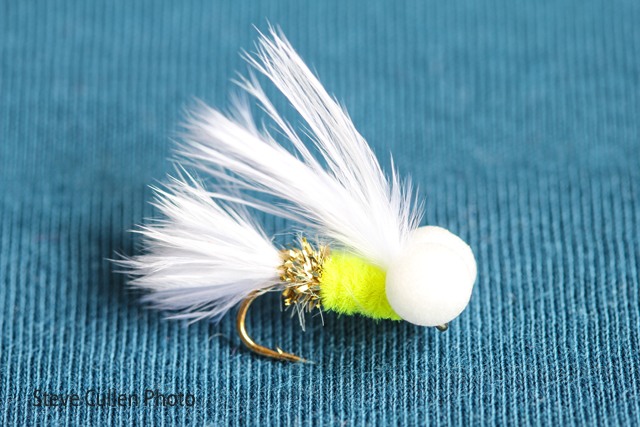
Gold-ass Cat's Whisker - great as part of a "washing line"
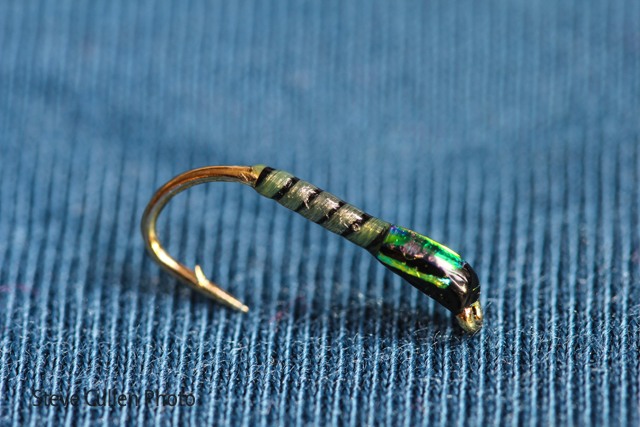
These buzzers will sink surprisingly fast
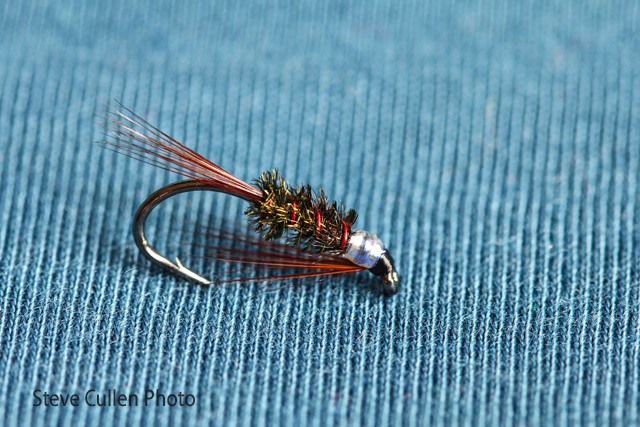
Blue UV head Diawl Bach - a buzzer pattern for pulling as well as drifting
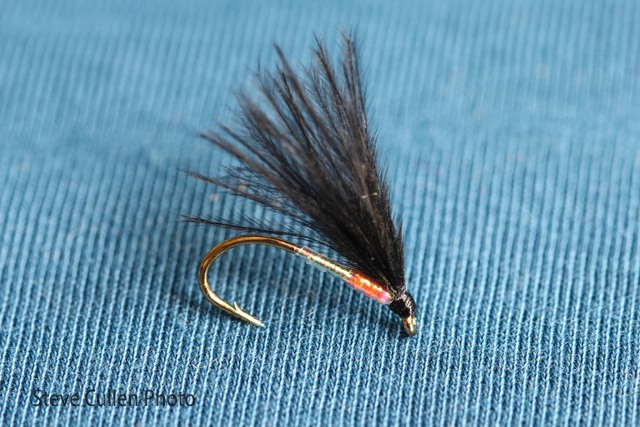
The "Cormorant" style is halfway between a lure and an imitative pattern
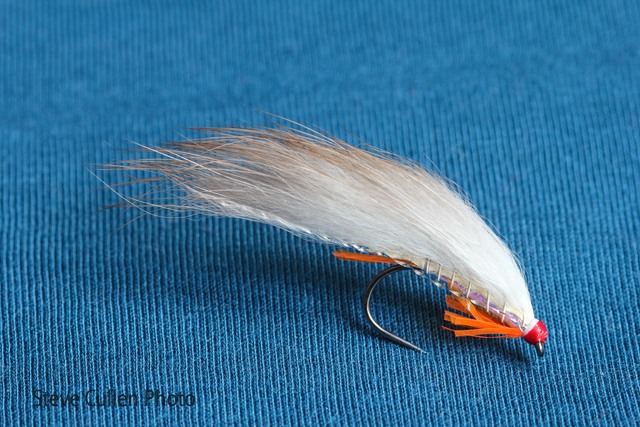
Steve's Appetiser Minkie - a great fry pattern
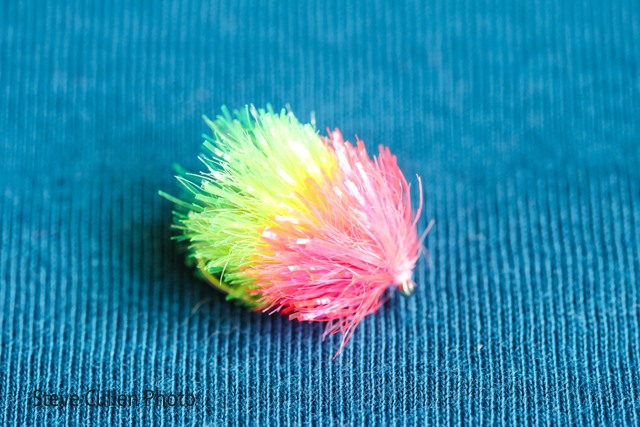
An out-and-out lure: The infamous Blob
You can see more of Steve’s Patterns and find insights behind this selection by connecting with him on his Facebook profile. and his Instagram.
Stocked Trout Fishing in Rivers
In contrast to enclosed lakes or drinking reservoir systems, adding additional trout biomass to rivers has a lot more implications for wild trout that could live and reproduce there. For this reason, we would encourage fly fishing clubs on rivers to reduce or move away from stocking their beats.
Here's a demonstration (using beer!) of carrying capacity and issues of increased predation of wild stocks associated with stocked trout fishing in rivers:
Stocked Trout Fishing Roundup
Here's a quick rundown of the main take-home messages from this article...
From this article you can:
Look out for our Additional Coaching Media on Stillwater Fly Fishing (Coming soon in our members' area)
I hope you've enjoyed this article - please let me know what you think of it in the comments below. Plus, if you found any of it useful, please consider using the social share buttons to spread the word to your friends and followers.
Paul
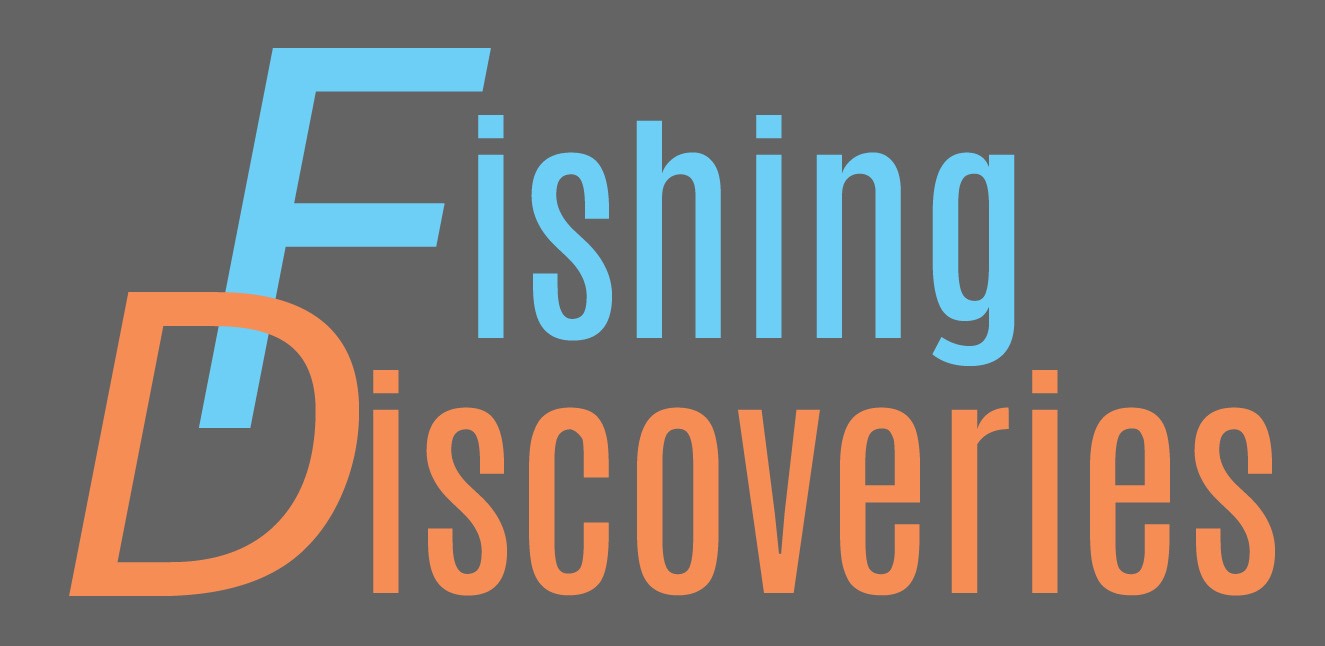
Very Very good information. Your advice is concise and understandable.
Steve’s comments on stocked and wild trout should be seen by every States Fisheries Department!